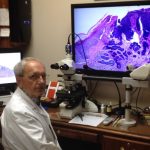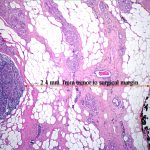MAMMARY CARCINOMA
What’s in a name? MAMMARY CARCINOMA
Recently a friend of mine, a superb mammographer, asked me about the diagnostic names we pathologists specifically call breast cancer. I asked him why he would ask such a question. And he went on to tell me one pathology group he works with only uses mammary carcinoma as a diagnosis. He asked if our group had shifted to that all-inclusive diagnosis. My answer was no.
There are many different forms of breast (or mammary) cancer and using an all-inclusive diagnosis doesn’t tell the treating physicians everything they need to know. The more information gleaned from the needle core biopsy, the more information the surgeon, medical and radiation oncologists have to personalize the treatment. So, we pathologists not only diagnose the specific type of breast cancer, but we also grade it based on the tumor’s ability to form duct like structures made up of the cancer cells, grade the nuclei (1 to 3) and evaluate the mitotic (cell divisions) activity. On the same sliver of breast tissue that we make the diagnosis, we also test for estrogen and progesterone receptors. In addition, for invasive tumors, we assess another important cell product, a growth-promoting protein called HER2 to determine whether it is amplified or non-amplified.
G lossary:
IDC = Invasive ductal carcinoma
ILC = Invasive lobular carcinoma
Lobulo-ductal = Mixed ductal and lobular CA
You will notice that the first three specific tumor types represent about 90% of invasive breast cancers. The percentages within the parentheses represent in the incidence of each specific breast type. The other sub-types occur far less often and some are rarely identified.
The important message is that by identifying each breast cancer as specifically as possible provides more information to the treating physicians. The behavior of these various breast cancer types can vary significantly from one type to another. The treating physicians want to know specifically which tumor is present in the breast mass.
If you are fortunate to be in a comprehensive breast center where a breast team works, the pathologists working in these centers know what the team expects from a malignant diagnosis: specific diagnostic name, histologic grade, ER and PR status, Her2neu status if the tumor is invasive.
To learn more about our pathologists who participate in several comprehensive breast centers, please visit North Houston Pathology Associates in this website.



